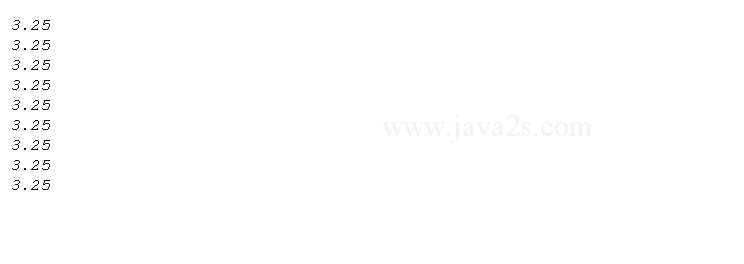Java - Data Types double type
Introduction
Java double data type uses 64 bits to store a floating-point number in the IEEE 754 standard format.
A floating-point number represented in 64 bits according to IEEE 754 standard is known as a double-precision floating-point number.
Java double type can represent a number from 4.9 x 10^-324 to 1.7 x 10^308 (approx.).
All real numbers are called double literals. A double literal may optionally end with d or D, for example, 12.34d.
Both 12.34 and 12.34d represent the same double literal.
double type literal
A double literal can be expressed in the following two formats:
- Decimal number format
- Scientific notation
Examples of double literals in decimal number format are as follows.
8 is an int literal whereas 8D, 8., and 8.0 are double literals.
d1 = 8D d2 = 8.; d3 = 8.0; d4 = 8.D; d5 = 8.1234; d6 = 85.0;
Demo
public class Main { public static void main(String[] args) { double d1 = 8D; double d2 = 8.; double d3 = 8.0; double d4 = 8.D; double d5 = 8.1234; double d6 = 85.0; System.out.println(d1);/*from w w w. ja va2 s. com*/ System.out.println(d2); System.out.println(d3); System.out.println(d4); System.out.println(d5); System.out.println(d6); } }
Result

Use scientific notation to express double literals.
d1 = 32.5E-1; d2 = 0.325E+1; d3 = 0.325E1; d4 = 0.0325E2; d5 = 0.0325e2; d6 = 32.5E-1D; d7 = 0.325E+1d; d8 = 0.325E1d; d9 = 0.0325E2d;
Demo
public class Main { public static void main(String[] args) { double d1 = 32.5E-1; double d2 = 0.325E+1; double d3 = 0.325E1; double d4 = 0.0325E2; double d5 = 0.0325e2; double d6 = 32.5E-1D; double d7 = 0.325E+1d; double d8 = 0.325E1d; double d9 = 0.0325E2d; System.out.println(d1);/*from w w w . ja va 2 s .co m*/ System.out.println(d2); System.out.println(d3); System.out.println(d4); System.out.println(d5); System.out.println(d6); System.out.println(d7); System.out.println(d8); System.out.println(d9); } }
Result

Exercise
- Write code to Make the verdict string specified is whether the numerical value.
- Write code to Check if the supplied value is a double
- Write code to convert String To Double
- Write code to convert String To Int via Double.valueOf()
- Write code to parse Double from String
- Write code to format double value to percentage
- Write code to round a double value by precision
- Write code to Convert a double to a string by format
- Write code to parse Double from string and catch exception
- Write code to parse string to double with comma Separator
- Write code to check if a string is Numeric using Double.parseDouble
- Write code to calculate Percentage
- Write code to format Money
- Get Average for three double values
- Write program to calculate triangle area from coordinates
- Calculate cost based on tip
- Read numbers and then read operations and then do the math
- Calculate Expression using double